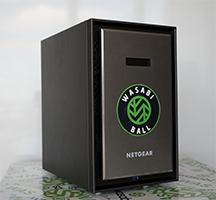Wasabi Ball Offers Fastest Time to Cloud Storage Savings
Wasabi Ball Offers Fastest Time to Cloud Storage Savings
Someone once asked me what I thought of Amazon’s Snowball transfer appliance. For those not familiar with it, Snowball is a disk storage array in a ruggedized shipping container. You basically rent it from Amazon to speed up the time it takes to move your data from your on-premises storage to Amazon’s cloud.
At first, I scoffed at the idea. Considering how cheap very high-speed Internet is these days, it seemed like an archaic approach to moving data. But now that more multi-petabyte customers are switching to our Wasabi hot cloud storage, I better understand the need for this type of transfer appliance. That’s why we just introduced our own (very creatively named) Wasabi Ball.
It Shouldn’t Take a Year to Upload Your Data
While a 10 Gbps Internet link is pretty fast, 10 petabytes of data is a massive (but not uncommon) amount of data. Let’s say you’re fortunate enough to have access to a 10 Gbps connection and want to move 10 petabytes from your on-premises data center to Wasabi. It’s going to take you over a year to get all that data uploaded. Here’s why:
While there are 8 bits to a byte, to make the math easy let’s say that 10 gigabits per second is roughly the same as 1 gigabyte per second. Follow me?
A petabyte is one million gigabytes, so transferring 10 petabytes at 1 gigabyte per second would take 10 million seconds. If you were uploading 24/7, that would be 116 days. However, if you have a 10 Gbps pipe it’s usually because you need a 10 Gbps pipe. In other words, it’s being used for normal business. Since you don’t want to clog it up during work hours, that leaves roughly 12 hours a day for uploads. So, double the time it would take to 232 days.
But, we’re not done because even during “off” hours you can’t chew up 100% of your company’s bandwidth. There are always other night-time activities such as backups, software updates, and various batch processes to contend with. So, we’ll conservatively estimate that 60-70% of available off-hours bandwidth can be dedicated to data uploads. That means it would take 380 days—well over a year to upload all 10 petabytes. That’s simply unacceptable.
Faster Time to Massive Savings
 One of our larger customers, IQ Media has a fascinating A.I. analytics solution that allows companies to search their library of real-time and historic global television programming to track every time their brand is mentioned, or their logo appears. As you can imagine, that’s a lot of data, so they want to move it to Wasabi as quickly as possible to begin realizing their savings. They’re using Wasabi Ball to migrate what could eventually be 6 petabytes of storage.
One of our larger customers, IQ Media has a fascinating A.I. analytics solution that allows companies to search their library of real-time and historic global television programming to track every time their brand is mentioned, or their logo appears. As you can imagine, that’s a lot of data, so they want to move it to Wasabi as quickly as possible to begin realizing their savings. They’re using Wasabi Ball to migrate what could eventually be 6 petabytes of storage.
We’re shipping them five high-capacity Wasabi Balls, each capable of transporting 87 terabytes of data. Because each appliance connects directly to their on-premises storage with its own 10 Gbps fiber link, they’re not clogging up their Internet bandwidth. It takes a little bit over a day to fill a Wasabi Ball and all five appliances can be used in parallel. Once full, the customer ships them to our data center for uploading to the Wasabi cloud, and we ship them five more Wasabi Balls.
In theory, 10 petabytes of data could be moved this way in just a couple of months. However, in practice, we’ve found that some companies can’t read data out of their own storage at this speed. But it is still a heck of a lot faster than trying to do it over the Internet. You get the job done quickly and get yourself out of the storage business once and for all. And that’s a big deal.
The Fast Way Out of the Storage Business
When someone sends us 10 petabytes of data, it’s usually because they have decided to shut down 10 petabytes of on-premises storage. The cost savings are enormous and undeniable. I’ve posted an in-depth cost analysis before, but here’s the shorthand version:
The capital investment in Dell EMC or equivalent hardware required to store 10 petabytes of data is approximately $5 million. Annual maintenance is 20% of hardware costs, or $1 million a year. Then there are all the attendant data center costs for space and power, plus technical staff.
10 PB of On-Premises Storage (Cost Per Year)
Storage hardware
$1,000,000
Annual maintenance
$1,000,000
Ancillary hardware/software
$100,000
Ancillary maintenance
$100,000
Power and cooling
$250,000
Headcount
$750,000
Total
$3,200,000 per year
In contrast, 10 petabytes of storage with Wasabi would cost you just $600,000 per year. So once the decision is made to migrate it’s understandable why customers with petabytes of data would want to transition that data as quickly as possible.
Migrating from on-premises storage to the Wasabi cloud is not only a huge financial savings, it allows you to focus your technical resources on problems that really matter to your business. With no more hardware and software to maintain and upgrade, you can free up a lot of staff time as well as space in your data center.
Data Storage Shouldn’t Be Complicated
Data storage should be a simple, cheap, and safe utility, just like electricity or bandwidth. Considering the economics of cloud storage 2.0 vendors like Wasabi, there’s no reason for most companies to still be in the data storage business. Wasabi Ball is one of many things we’re doing to help you make the transition as painless as possible.
the bucket
Someone once asked me what I thought of Amazon’s Snowball transfer appliance. For those not familiar with it, Snowball is a disk storage array in a ruggedized shipping container. You basically rent it from Amazon to speed up the time it takes to move your data from your on-premises storage to Amazon’s cloud.
At first, I scoffed at the idea. Considering how cheap very high-speed Internet is these days, it seemed like an archaic approach to moving data. But now that more multi-petabyte customers are switching to our Wasabi hot cloud storage, I better understand the need for this type of transfer appliance. That’s why we just introduced our own (very creatively named) Wasabi Ball.
It Shouldn’t Take a Year to Upload Your Data
While a 10 Gbps Internet link is pretty fast, 10 petabytes of data is a massive (but not uncommon) amount of data. Let’s say you’re fortunate enough to have access to a 10 Gbps connection and want to move 10 petabytes from your on-premises data center to Wasabi. It’s going to take you over a year to get all that data uploaded. Here’s why:
While there are 8 bits to a byte, to make the math easy let’s say that 10 gigabits per second is roughly the same as 1 gigabyte per second. Follow me?
A petabyte is one million gigabytes, so transferring 10 petabytes at 1 gigabyte per second would take 10 million seconds. If you were uploading 24/7, that would be 116 days. However, if you have a 10 Gbps pipe it’s usually because you need a 10 Gbps pipe. In other words, it’s being used for normal business. Since you don’t want to clog it up during work hours, that leaves roughly 12 hours a day for uploads. So, double the time it would take to 232 days.
But, we’re not done because even during “off” hours you can’t chew up 100% of your company’s bandwidth. There are always other night-time activities such as backups, software updates, and various batch processes to contend with. So, we’ll conservatively estimate that 60-70% of available off-hours bandwidth can be dedicated to data uploads. That means it would take 380 days—well over a year to upload all 10 petabytes. That’s simply unacceptable.
Faster Time to Massive Savings
 One of our larger customers, IQ Media has a fascinating A.I. analytics solution that allows companies to search their library of real-time and historic global television programming to track every time their brand is mentioned, or their logo appears. As you can imagine, that’s a lot of data, so they want to move it to Wasabi as quickly as possible to begin realizing their savings. They’re using Wasabi Ball to migrate what could eventually be 6 petabytes of storage.
One of our larger customers, IQ Media has a fascinating A.I. analytics solution that allows companies to search their library of real-time and historic global television programming to track every time their brand is mentioned, or their logo appears. As you can imagine, that’s a lot of data, so they want to move it to Wasabi as quickly as possible to begin realizing their savings. They’re using Wasabi Ball to migrate what could eventually be 6 petabytes of storage.
We’re shipping them five high-capacity Wasabi Balls, each capable of transporting 87 terabytes of data. Because each appliance connects directly to their on-premises storage with its own 10 Gbps fiber link, they’re not clogging up their Internet bandwidth. It takes a little bit over a day to fill a Wasabi Ball and all five appliances can be used in parallel. Once full, the customer ships them to our data center for uploading to the Wasabi cloud, and we ship them five more Wasabi Balls.
In theory, 10 petabytes of data could be moved this way in just a couple of months. However, in practice, we’ve found that some companies can’t read data out of their own storage at this speed. But it is still a heck of a lot faster than trying to do it over the Internet. You get the job done quickly and get yourself out of the storage business once and for all. And that’s a big deal.
The Fast Way Out of the Storage Business
When someone sends us 10 petabytes of data, it’s usually because they have decided to shut down 10 petabytes of on-premises storage. The cost savings are enormous and undeniable. I’ve posted an in-depth cost analysis before, but here’s the shorthand version:
The capital investment in Dell EMC or equivalent hardware required to store 10 petabytes of data is approximately $5 million. Annual maintenance is 20% of hardware costs, or $1 million a year. Then there are all the attendant data center costs for space and power, plus technical staff.
10 PB of On-Premises Storage (Cost Per Year)
| Storage hardware | $1,000,000 |
| Annual maintenance | $1,000,000 |
| Ancillary hardware/software | $100,000 |
| Ancillary maintenance | $100,000 |
| Power and cooling | $250,000 |
| Headcount | $750,000 |
| Total | $3,200,000 per year |
In contrast, 10 petabytes of storage with Wasabi would cost you just $600,000 per year. So once the decision is made to migrate it’s understandable why customers with petabytes of data would want to transition that data as quickly as possible.
Migrating from on-premises storage to the Wasabi cloud is not only a huge financial savings, it allows you to focus your technical resources on problems that really matter to your business. With no more hardware and software to maintain and upgrade, you can free up a lot of staff time as well as space in your data center.
Data Storage Shouldn’t Be Complicated
Data storage should be a simple, cheap, and safe utility, just like electricity or bandwidth. Considering the economics of cloud storage 2.0 vendors like Wasabi, there’s no reason for most companies to still be in the data storage business. Wasabi Ball is one of many things we’re doing to help you make the transition as painless as possible.
featured articles
WASABI MEDIA & ENTERTAINMENT
April 10, 2024
Introducing Wasabi AiR: Unleash the Power of AI wit...
Introducing Wasabi AiR: Unleash the Power of AI wi...
TECH PARTNERS HEALTHCARE
April 18, 2024
Protect Your Research Data with Cost-friendly, Powe...
Protect Your Research Data with Cost-friendly, Pow...
TECH PARTNERS
April 11, 2024
Addressing AI Infrastructure Challenges with Wasabi...
Addressing AI Infrastructure Challenges with Wasab...
VIDEO SURVEILLANCE
April 9, 2024
Why More Organizations Are Choosing Cloud Storage f...
Why More Organizations Are Choosing Cloud Storage ...
TECH PARTNERS
April 10, 2024





